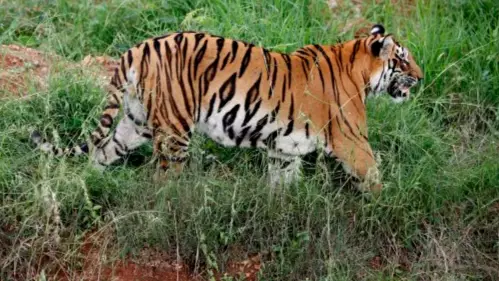
If you thought your trek up Snowdonia was impressive, just check out the mileage by this tiger over in India.
The two-and-a-half year-old male is believed to have completed the 'longest walk ever', having roamed for more than 808 miles (1,300km) in five months across forests, farms, roads and villages.
Conservationists believe the big cat didn't settle for so long as it was either in search of territory, prey or a mate.
Advert
Known as C1, the tiger was born in Tipeshwar wildlife sanctuary in late 2016, and was fitted with a radio collar in February that features GPS tracking.
C1 was then let out into the wild - little did the researchers realise the journey he was about to embark on.
Govekar Ravikiran, field director of Pench tiger reserve, said: "The purpose of the study was to monitor the dispersal pattern of sub-adults which are normally in the process of exploring new areas to set up their territory."
Meanwhile, Bilal Habib, a senior biologist at the Wildlife Institute of India, told Sky News that this is the longest walk undertaken by a tiger.

"We know this because C1 is radio-collared," he explained.
Advert
"It's clear that with shrinking space, we need to redraft policy to ensure safety of tigers like C1.
"A tiger needs three things to become stable at any place - space, food and mate. Dnyanganga has space and enough prey base, though if (C1) doesn't find a mate, it might keep walking further."
The tiger made it through seven districts in Maharashtra and neighbouring Telangana before coming to a rest in Dnyanganga sanctuary in Buldhana, with virtually any issues... virtually.
There was one run-in with a human that resulted in injury, although apparently the incident was avoidable and down to the fact that the man had been with a group exploring the area where C1 was resting.
Advert
The group are said to have approached the tiger 'very closely' before it bit back, although it only resulted in a minor injury.
Aside from that, the research team said the tiger 'never entered into any conflict with humans except the cattle kills that he made for survival'.
Sounds like C1 has been on quite the journey - and he's not alone. Although for years experts have feared the extinction of the species, recent figures suggest a positive outlook.

At the turn of the decade, there were just 3,200 tigers left, according to the Metro.
Advert
However, a study in Science Advances has discovered that forest loss in tiger habitats is not as bad as we thought. In fact, if it stays the same their numbers could rise.
In India, tiger numbers have increased by 61 percent and in Nepal they've risen by 31 percent. Great news - hopefully these figures continue to grow.
Featured Image Credit: PATopics: Tiger, World News, Animals, India